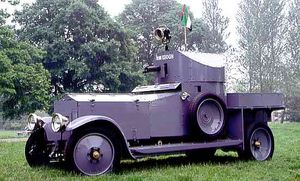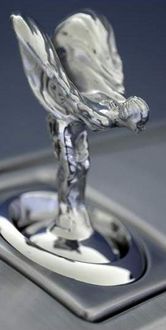.
Rolls-Royce Armoured Car: Difference between revisions
Red marquis (talk | contribs) No edit summary |
Red marquis (talk | contribs) No edit summary |
||
| (6 intermediate revisions by the same user not shown) | |||
| Line 1: | Line 1: | ||
{| border=0 cellspacing=0 cellpadding=4 style="float:right; margin:0 0 .5em 1em; width:250px; background:#fff; border-collapse:collapse; border:1px solid #999; font-size:83%; line-height:1.5; " summary="Infobox Automobile" | |||
|- style="text-align:center; background:#f0f0f0;" | |||
| colspan=2 style="padding:0; background:#996; color:#fff; border-bottom:1px solid #999;" | [[Image:Sg101c.jpg|300px]] | |||
|- style="color:#fff; background:#996; font-size:larger;" | |||
! colspan=2 | '''Rolls-Royce Armoured Car''' | |||
|- | |||
! colspan=2 style="text-align:center; font-weight:normal; background:#ddb;" | [[Rolls-Royce]] | |||
|- style="vertical-align:top;" | |||
| aka | |||
| | |||
|- style="vertical-align:top; background:#f0f0f0;" | |||
| Production | |||
| | |||
|- style="vertical-align:top;" | |||
| Class | |||
| | |||
|- style="vertical-align:top; background:#f0f0f0;" | |||
| Body Style | |||
| | |||
|- style="vertical-align:top;" | |||
| Length | |||
| | |||
|- style="vertical-align:top; background:#f0f0f0;" | |||
| Width | |||
| | |||
|- style="vertical-align:top;" | |||
| Height | |||
| | |||
|- style="vertical-align:top; background:#f0f0f0;" | |||
| Wheelbase | |||
| | |||
|- style="vertical-align:top;" | |||
| Weight | |||
| | |||
|- style="vertical-align:top; background:#f0f0f0;" | |||
| Transmission | |||
| | |||
|- style="vertical-align:top;" | |||
| Engine | |||
| | |||
|- style="vertical-align:top; background:#f0f0f0;" | |||
| Power | |||
| | |||
|- style="vertical-align:top;" | |||
| Similar | |||
| | |||
|- style="vertical-align:top; background:#f0f0f0;" | |||
| Designer | |||
| | |||
|} | |||
The '''Rolls-Royce armoured car''' was a British [[armored car|armoured car]] developed in 1914 and used in World War I and in the early part of World War II. | The '''Rolls-Royce armoured car''' was a British [[armored car|armoured car]] developed in 1914 and used in World War I and in the early part of World War II. | ||
==Production history== | ==Production history== | ||
The | The Royal Naval Air Service raised the first British [[armored car]] squadron during the First World War. In September 1914 all available [[Rolls-Royce Limited|Rolls Royce]] ''[[Silver ghost]]'' chassis were requisitioned. In October 1914 a special committee of the Admiralty Air Department among whom was Flight Commander T.G. Hetherington designed the superstructure. The first three vehicles were delivered on 3 December 1914. The vehicle was based on a Rolls Royce 40/50 hp car chassis (the engine had a maximum output of about 80 hp), to which were added armoured bodywork and a single turret for a Vickers machine gun. | ||
The vehicle was modernized in | The vehicle was modernized in 1920 and in 1924, resulting in '''Rolls-Royce 1920 Pattern''' and '''Rolls-Royce 1924 Pattern'''. In 1940, 34 vehicles which served in Egypt with the 11th Hussars regiment had the "old" turret replaced with an open-topped one carrying a Boys anti-tank rifle, .303 inch Bren machine gun and smoke grenade launchers. | ||
Some vehicles in Egypt received new chassis from a Fordson truck and became known as '''Fordson Armoured Car'''s. Pictures [http://ww2photo.mimerswell.com/tanks/gb/bil/ford/fordson.htm] show them as equipped with what appears to be turrets fitted with a Boys ATR, a machine gun and twin light machine guns for anti-aircraft defence. | Some vehicles in Egypt received new chassis from a Fordson truck and became known as '''Fordson Armoured Car'''s. Pictures [http://ww2photo.mimerswell.com/tanks/gb/bil/ford/fordson.htm] show them as equipped with what appears to be turrets fitted with a Boys ATR, a machine gun and twin light machine guns for anti-aircraft defence. | ||
==Combat history== | ==Combat history== | ||
Six RNAS Rolls-Royce squadrons were formed of 12 vehicles each: one went to France; one to Africa to fight in the German colonies and in April 1915 two went to Gallipoli. From August 1915 onwards these were all disbanded and the material handed over to the Army which used them in the Light Armoured Motor Batteries. | |||
Armoured cars were poorly suited to the muddy trench filled battlefields of the Western Front, but were able to operate in the Near East, so the squadron from France went to Egypt. Lawrence of Arabia used one vehicle in his operations against the Turkish forces. | |||
At the outbreak of the World War II 76 vehicles were in service. They were used in operations in the | In the Irish Civil War (1922-1923), Rolls Royce armoured cars were given to the Irish Free State government by the British government to fight the Irish Republican Army. They were a major advantage to the Free State in street fighting and in protecting convoys against guerrilla attacks. | ||
At the outbreak of the World War II 76 vehicles were in service. They were used in operations in the Western Desert. By the end of 1941 they were withdrawn as modern armoured car designs became available. Some Indian Pattern cars saw use in the Indian subcontinent and Burma. | |||
==Variants== | ==Variants== | ||
| Line 25: | Line 74: | ||
*'''Rolls Royce Indian Pattern''' - based on a 1920 Pattern. Had extended hull armour to provide extra space and a domed turret with four ball mounts for machine guns. | *'''Rolls Royce Indian Pattern''' - based on a 1920 Pattern. Had extended hull armour to provide extra space and a domed turret with four ball mounts for machine guns. | ||
A single experimental vehicle had the turret removed and replaced by a one-pounder automatic anti-aircraft gun on an open mounting. Some cars had | A single experimental vehicle had the turret removed and replaced by a one-pounder automatic anti-aircraft gun on an open mounting. Some cars had Maxim machine guns instead of the Vickers gun. | ||
==Gallery== | |||
<gallery> | |||
Image:Sg101b.jpg | |||
Image:Sg101g.jpg | |||
</gallery> | |||
{{Rolls-Royce}} | |||
==External links== | ==External links== | ||
Latest revision as of 02:09, 5 February 2007

| |
| Rolls-Royce Armoured Car | |
|---|---|
| Rolls-Royce | |
| aka | |
| Production | |
| Class | |
| Body Style | |
| Length | |
| Width | |
| Height | |
| Wheelbase | |
| Weight | |
| Transmission | |
| Engine | |
| Power | |
| Similar | |
| Designer | |
The Rolls-Royce armoured car was a British armoured car developed in 1914 and used in World War I and in the early part of World War II.
Production history
The Royal Naval Air Service raised the first British armored car squadron during the First World War. In September 1914 all available Rolls Royce Silver ghost chassis were requisitioned. In October 1914 a special committee of the Admiralty Air Department among whom was Flight Commander T.G. Hetherington designed the superstructure. The first three vehicles were delivered on 3 December 1914. The vehicle was based on a Rolls Royce 40/50 hp car chassis (the engine had a maximum output of about 80 hp), to which were added armoured bodywork and a single turret for a Vickers machine gun.
The vehicle was modernized in 1920 and in 1924, resulting in Rolls-Royce 1920 Pattern and Rolls-Royce 1924 Pattern. In 1940, 34 vehicles which served in Egypt with the 11th Hussars regiment had the "old" turret replaced with an open-topped one carrying a Boys anti-tank rifle, .303 inch Bren machine gun and smoke grenade launchers.
Some vehicles in Egypt received new chassis from a Fordson truck and became known as Fordson Armoured Cars. Pictures [1] show them as equipped with what appears to be turrets fitted with a Boys ATR, a machine gun and twin light machine guns for anti-aircraft defence.
Combat history
Six RNAS Rolls-Royce squadrons were formed of 12 vehicles each: one went to France; one to Africa to fight in the German colonies and in April 1915 two went to Gallipoli. From August 1915 onwards these were all disbanded and the material handed over to the Army which used them in the Light Armoured Motor Batteries.
Armoured cars were poorly suited to the muddy trench filled battlefields of the Western Front, but were able to operate in the Near East, so the squadron from France went to Egypt. Lawrence of Arabia used one vehicle in his operations against the Turkish forces.
In the Irish Civil War (1922-1923), Rolls Royce armoured cars were given to the Irish Free State government by the British government to fight the Irish Republican Army. They were a major advantage to the Free State in street fighting and in protecting convoys against guerrilla attacks.
At the outbreak of the World War II 76 vehicles were in service. They were used in operations in the Western Desert. By the end of 1941 they were withdrawn as modern armoured car designs became available. Some Indian Pattern cars saw use in the Indian subcontinent and Burma.
Variants
- 1920 Pattern Mk I - thicker radiator armor and new wheels.
- 1920 Pattern Mk IA - commander's cupola.
- 1924 Pattern Mk I - turret with commander's cupola.
- Rolls Royce Indian Pattern - based on a 1920 Pattern. Had extended hull armour to provide extra space and a domed turret with four ball mounts for machine guns.
A single experimental vehicle had the turret removed and replaced by a one-pounder automatic anti-aircraft gun on an open mounting. Some cars had Maxim machine guns instead of the Vickers gun.
Gallery

| ||
| ROLLS-ROYCE | ||
|
BMW | Rolls-Royce | Mini Current Models: Phantom (VII) · Drophead · Phantom Coupe · Ghost Historic Models: Silver Seraph · Silver Spur / Flying Spur · Silver Spirit · Silver Shadow · Silver Cloud · Silver Wraith · Silver Dawn · Silver Ghost · 10 HP · 15 HP · 20 HP · 20/25 · 30 HP · 25/30 Wraith · Camargue · Corniche · Phantom I · Phantom II · Phantom III · Phantom IV · Phantom V · Phantom VI · Armoured Car · Legalimit Concept Cars: 1EX · 100EX · 101EX · 200EX Concept Specials: FAB 1 · Cloudesque · Silver Ghost Boat Tail Speedster · Silver Spur Hooper Landaulette · Phantom II Star of India | ||
| Sir Henry Royce and Charles Rolls | Corporate website | A brand of BMW AG |
External links
| Wikimedia Commons has media related to: |
- I. Moschanskiy - Armored vehicles of the Great Britain 1939-1945 part 2, Modelist-Konstruktor, Bronekollektsiya 1999-02 (И. Мощанский - Бронетанковая техника Великобритании 1939-1945 часть 2, Моделист-Конструктор, Бронеколлекция 1999-02).
- Equipment Used By the Armoured Car Regiments
- Tankmuseum.co.uk
- War Diary of Armoured Car Section, Rangoon Battalion, BAF


